Mission Data :
Flight Data | ||
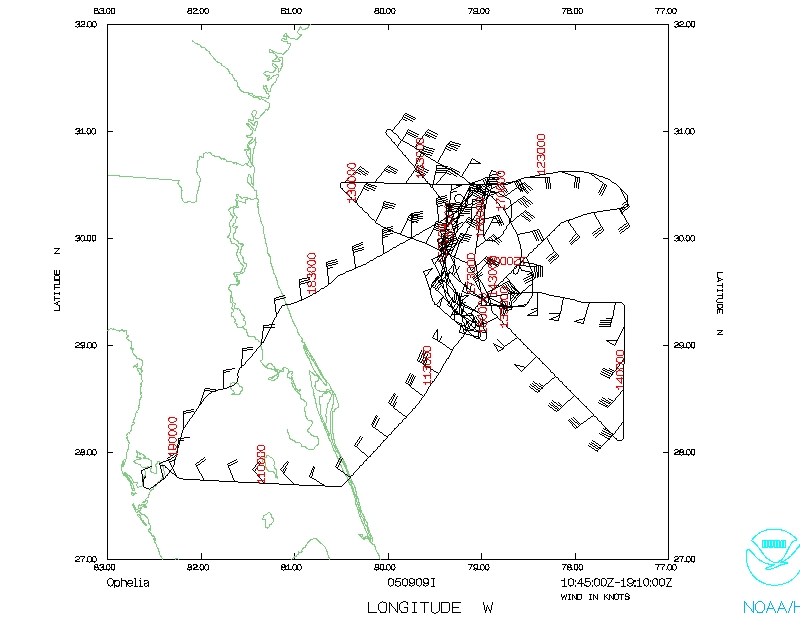 Flight track |
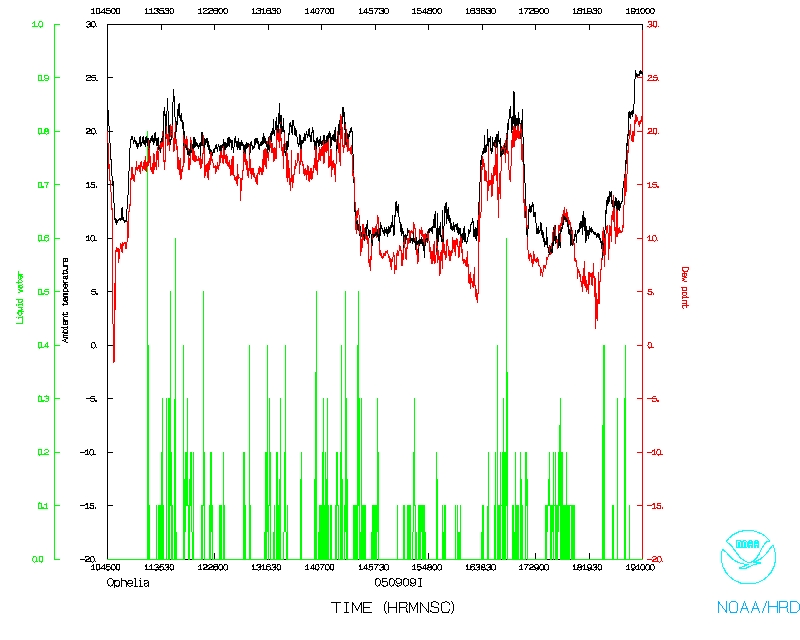 Temperature and Moisture |
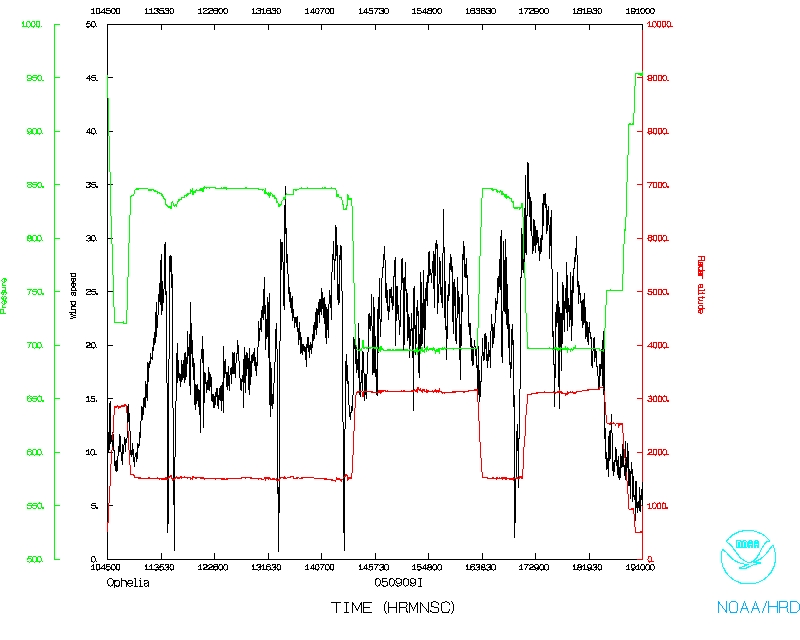 Wind and Atlitude |
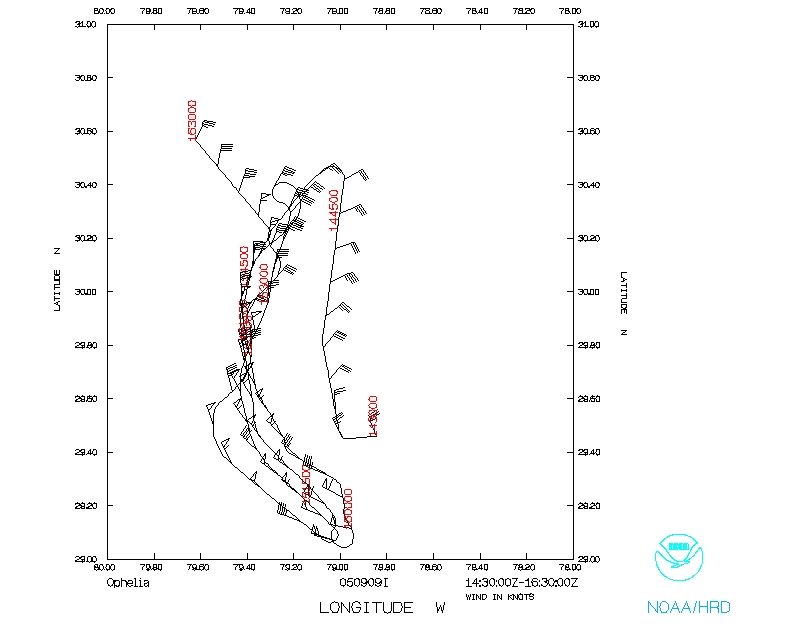 Flight track detail |
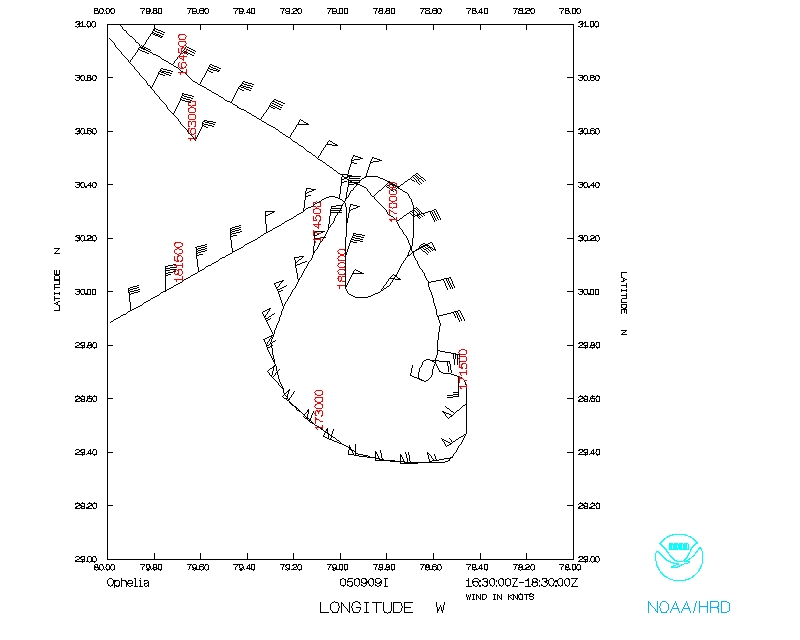 Flight track detail |
|
| Rob Rogers | LPS |
| Peter Dodge | Radar |
| Sim Aberson | Dropsonde |
| Brad Smull (UWash) | Cloud Physics |
| Ed Walsh (GSFC) | SRA |
| Randy Tebeest, Mike Silah, Barry Choy | Pilots |
| Joe Kippel | Flight Engineer |
| Tim Gallagher | Navigator |
| Barry Damiano, Martin Mayeaux | Flight Directors |
| Terry Lynch, Damon San Souci, Ray Tong | Engineers |
The NOAA N43RF will fly an NHC-tasked mission into newly-downgraded Tropical Storm Ophelia. The NOAA P3 will leave MacDill AFB, FL at 06:40 AM EDT and fly a single figure-4 pattern at 5000 ft., repeating legs (i.e., no rotation). The fix times are 12, 15, and 18 UTC. Drops sondes for NHC at center and RMW, drop RAINEX sondes at turn points. At the end of the fix responsibility, climb to 10,000 ft., and begin coordinated pattern with the NRL P-3 for a RAINEX module. A possible band to target around the north and the east side of the storm. The initial plan calls for the NOAA P-3 to be set up on the inside of the band and the NRL P-3 on the outside of the band. The IP for the fix pattern is 105 nm SW of the storm. The leg lengths are 105 nm. NOAA 43 will recover at MacDill AFB, FL at 03:20 PM EDT. This will also serve as the final mission of 12-h Frequent Monitoring. There have been six missions over a three-day time period.
Mission Summary :
Ophelia continues to linger off the east coast of Florida. Infrared satellite imagery (Fig. 1) shows that Ophelia is not experiencing as much shear as the previous day, but it is continuing to experience some southeasterly shear. This shear is confirmed by the CIMSS shear analysis product (Fig. 2). The eye of the storm is visible from Jacksonville radar (Fig. 3), which also shows a band of strong rain on the west side of the storm wrapping around to the southwest side.
N43RF had a tasked mission today, with fix responsibilities at 12, 15, and 18 UTC. There is also a requirement for a figure-4 pattern to be flown at 5000 ft, with leg lengths of 105 nm. The NOAA P3 left MacDill AFB,FL at 06:40 AM EDT. GPS sondes would be dropped for NHC at the center and at the RMW, while RAINEX sondes would be dropped at the turn points. At the end of the fix responsibility, N43RF would climb to 10,000 ft and begin a coordinated pattern with the NRL P-3 for a RAINEX rainband module. There was a possible band to target around the north and west side of the storm, as evident from the radar image (cf. Fig. 2).
The actual pattern flown was similar to that planned (Fig. 4). The system was experiencing shear, and the pressure was lower than before, but the winds were not much higher. In between the second and third fix, N43RF flow along a rainband on the west and northwest side of the storm. N43RF flew two downwind and two upwind legs (Fig. 5). It was outside the band, while the NRL P-3 was inside the band. After the third fix, N43RF set up for an upwind leg along the principal rain band on the west side. The aircraft tried to come back on the inner edge to follow down to its intersection with the eyewall, which would have made for a great set of observations for RAINEX. However, it was not deemed safe, so the pattern was abandoned. NOAA 43 recovered at MacDill AFB, FL at 03:20 PM EDT.
Overall, the mission was very good. N43RF accomplished its tasking objectives and found that the storm pressure had dropped while the wind speed had maintained constant strength. There was good coordination with the NRL P-3, with passes on opposite sides of two rainband features at two different times. On the first pass the rainband was within 10 km for much of the leg with N43RF. This close proximity should provide great Dual-Doppler coverage. This mission marked the end of the 12-h intervals for the NOAA P-3Ős being in the system, and thus marked the end of the 12-h portion of the Frequent-Monitoring experiment for this storm. There have been six missions in Ophelia in a three-day time period, each of them including radar and dropsonde observations and two of them including the NRL P-3 as well.
Problems :
There were no significant problems on this mission. The sondes had a very high success rate. Two of the four BTs failed.
Robert Rogers
9/17/05
Mission Data :
Flight Data | ||
 Flight track |
 Temperature and Moisture |
 Wind and Atlitude |
 Flight track detail |
 Flight track detail |
|